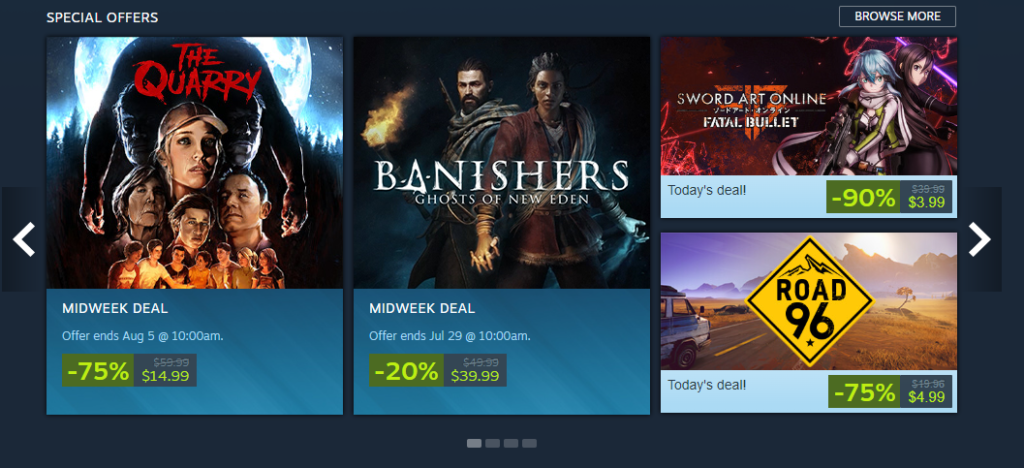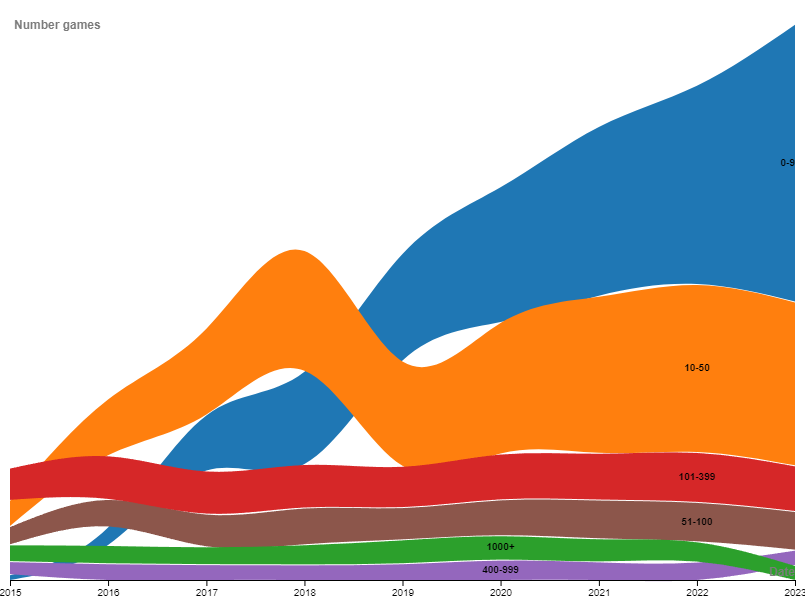I see this a lot. I have worked on games like this:
A well-crafted game releases that have sales that are ok, but not great. And these games did everything right! They followed the basic marketing meta of entering into festivals, sending their demo to content creators, creating a tiktok account, just to name a few. They released with a decent number of wishlists (10,000 or maybe even 30,000). They got into popular upcoming (maybe even New & Trending). The game has no major bugs, and the game is made by an experienced team, not some first-time, hobbyist project. But within the first month of launch the game stalls out at 150ish reviews. The reviews are “very positive” (average user review score is 88%-95% positive).
At this point the developers throw their hands up and say “WHAT DO YOU WANT STEAM?!? I have very positive reviews but no sales? No major bugs! WHY WON’T YOU SHOW MY GAME!?!”
“If only Steam would show my game more, I would be able to sell more copies!”
In this blog post I am going to explain what I think is going on.
Excitement is the unmeasurable factor
There are so many games released every day that players can be picky. There are hundreds of “good” games out there and players have huge backlogs of unplayed games. They can be picky.
In fact, players are picky.
Steam fans can play the most exciting games that are in their favorite genre and never run out of content.
I am more and more convinced that the Steam algorithm is built around elevating games that have that certain “magic” that have some “je ne sais quoi” that makes people buy it right away, start playing it, sharing it with their friends, posting about it on social media, and recommending it to their favorite content creator (and that creator playing it over and over again).
There are “good” games and then there are EXCITING games that make people buy them right away.
There is nothing wrong with just “good” games. A good game has no real flaws. But a “good” game doesn’t stop people in their tracks and demand that they play it.
Ultimately these games with 150ish “very positive” reviews stalled because they were “good.” They were “fine.”
Wanderbots touched on this phenomenon with his blog post called “Escaping Coverage Limbo. In short, he explains that when someone sends their game to him for coverage, he never gives definitive “no I won’t cover your game” because it isn’t that he hates your game, it is just that other games are more exciting and more relevant to him, and they jump the queue to get covered before yours.
Similar to review scores, streamers don’t play your game not because it is bad, but it just isn’t AMAZING!
The missing metric
When developers look at their review scores and see “95% positive” reviews they don’t see the secret metric which is “how many players just looked at the game and passed.”
Those players thought “eh, looks fine, maybe later.”
The number of positive reviews don’t capture EXCITEMENT. If someone isn’t excited about your game, they don’t buy it. They don’t play it. They don’t leave a review.
Opportunity cost
This is where the frustration comes in. Developers look at their 95% positive review scores and curse in the general direction of Steam yelling “WHY WON’T YOU SHOW MY GAME MORE! 95% of people like it!”
That is not how it works though.
95% positive does not mean that 95% of all people like the game. It just means 95% of the people who were excited enough to buy it, recommended the game.
The key number Valve uses to determine what games to promote is not review positivity, or “visits”, it only cares about dollars earned.
Steam knows exactly how much money your game earns when they show it. And you are compared to all other games on the platform.
Let me get specific.
This is the Special Offers widget and is one of the ways that Valve promotes a game that it believes in. (For more info on how to get a Daily Deal or other Special Offer, read this blog post)

This widget can only promote 19 games per day.
If you just have a “good” game, and Steam puts you in this widget you could probably earn a decent amount of money. I have seen a lot of just “good” games earn $10,000 for a “Daily Deal” aka “Today’s deal!”
But there are lots of other games that if Valve put them in that widget, they will earn $20,000.
So YES, your game has 95% positive reviews. And yes there would be some people who would be excited and like your game. And yes if your game is shown in the Special Offers section you will earn a lot of money. But, in the eyes of the Valve algorithms, your game is taking up a slot of a game that could earn even more money, and could make even more people happy.
Opportunity Cost is the reason many “good” games stall out at 150 reviews that are “very positive.”
It is good, but there are games that perform even better under similar conditions so Valve emphasizes those games instead of yours.
Signs of lack of excitement.
Developers love to complain about Steam reviewers being idiots (especially when they see reviews that are like “100 hours on record” review: “not enough content”). But overall, I think Steam reviewers are very good and really perceptive about the weaknesses of a game.
For games that “stall out” at 150 reviews that are 95% positive, I usually see “faint praise” and they usually fall into these categories.
Note: All of the reviews I show here are from real games that achieved review ratings in the 80-98% positive range, but are from games that are stuck in that 150-ish review range.
Reason #1: Good but not exciting
Here are a couple examples:


Reason #2: Not enough content or lack of depth
Steam players love DEEEEP, LOOOONG games (even though many devs erroneously assume they want short games that respect their time).
Often reviewers will use the phrase “great first version, will check back for more content”
Or
“It lacks depth”



Reason #3: Slight jank
When I released my first games I underestimated how perfect a game must feel. I didn’t realize how much polish games require. I ignored edge cases that I should have smoothed out. Even simple games must feel perfect to the end player.
In today’s market, just a bit of jank can sink a game. This is also genre dependent too. Part of the reason platformers and souls-likes are so risky to make is that there are so many of them that they must be absolutely flawless in execution or fans will pick them apart. Other genres such as horror are allowed a BIT more janky (but not much more).
Relevant reviews. Look at how these reviews list a bunch of seemingly minor issues, but when they are added together, it seems like this game is a bit janky.


Reason #4: Game genre mismatch
Sometimes screenshots and trailers make people assume a game is in one genre, but once they play the game, they realize that the game was missing key genre anchors and doesn’t match their taste preferences. Essentially “The game is fine, just not my cup of tea”
Here are some example reviews:


Reason #5: Oversaturated genres with high quality games
In this category the game is fine, but it is being compared to the biggest games in the genre.
These reviews typically popup up in genres with a clear market leader or one that is VERY VERY high quality.

Look at this final review, it is literally describing opportunity cost. There are other games that are better than this one so by playing this game you are missing out on others.

Word of mouth
One of the big reasons “good but not great” games don’t sell well is that they miss out on word of mouth. In all my market research I found that a lot of people buy games after they are recommended by their friends.
Word of mouth operates outside of the Steam platform. It occurs in Discord DMs, text messages, and in-person conversations in the break room at work. There is no metric in the Steamworks backend that can show “word of mouth.” It is super important, we just can’t measure it.
This is why I call it “magic” when a game sells well. It is because un-measurable activity is occurring outside of Steam that is driving people to buy your game.
I found this meme posted on r/steam a while ago and it confirms exactly what I have found:

It is a lot of work to convince a friend to play a game. Players really have to put themselves out there and work hard to change a friend’s behavior. If your game is just “good” people won’t spend the extra effort to convince their friends to play your game.
Oversaturated Steam

People love to complain about the 14,000 games that launch every year (I project 17,000 this year). Probably 70% of those games are “hobbyist” first time developers.
Those developers are not dragging you down. They have 0 effect on how well your game does. The Steam algorithm buries them before anyone can see them.
The real competition and the real oversaturation is among the “eh, good enough” games that have 150-ish reviews. Those games are good but missing something that makes them TRULY exciting to compete with the games that earn 1000s of reviews.
How to fix this?
Unfortunately, this really is a game design problem. When a game gets 150 reviews but not more, that typically is a sign that a team did some great marketing to get a lot of people to wishlist and buy it at launch. Typically early adopters picked it up, tried it and went “ehhh, it’s ok.” That early “soft” reception is from the early adopters. When a game blows past the 150 review depth zone is because the game is so good those early adopters do “word of mouth.” Or the game is so good and exciting that when the Steam algorithm shows the game new people buy it immediately.
The way to fix it is to change the game.
It could be that the game has some jank. That can be fixed in code. But it is very hard to turn around initial perceptions.
It could be the combination of genre + setting + graphics + hook just aren’t in sync. If that is the case, there isn’t much you can do. I don’t think you can tweak those once the game is out. The game is the game. It is better just to release and market a new one with a different combination of those factors.
It could be that it just didn’t do anything new. But again, patching in new features or functions is not effective because of initial perceptions. It is better to direct those activities to new games.
There are so many reasons.
Game development is hard.
This is also the reason why so few developers do well with their first game. Very subtle game design choices can have a big effect on how well a game does.
Sorry I don’t have 1 easy fix that can make you earn $100,000.
I just wanted to help explain why a game might not be selling well despite getting quite a few positive reviews.